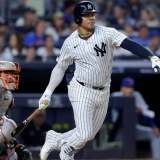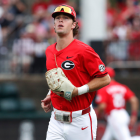
The New York Mets and the Los Angeles Dodgers will resume their tied National League Championship Series on Wednesday night with Game 3 at Citi Field. The starting pitching matchup will be a study in contrasts: Dodgers right-hander Walker Buehler is heading into free agency following the worst season of his career; Mets righty Luis Severino, conversely, is positioned to strike it rich this winter after a resurgent year.
Buehler shouldn't lack reference points concerning turnaround success stories -- not while inhabiting the same clubhouse as Jack Flaherty -- but, on the off chance he needs more reason for hope, he could do worse than studying Severino's story.
Remember, Severino entered free agency as a 29-year-old who had posted a 6.65 ERA in 89 1/3 innings. The accolades he had piled up earlier in his career, when he made two All-Star Games and received consideration for consecutive Cy Young Awards, no longer seemed relevant to the pitcher he had become -- especially not with how much injuries had impacted him over the ensuing years.
When Severino inked a one-year deal with the Mets, it felt like he arrived at a crossroads. Either he had to find a way to improve upon last season's showing in a meaningful way, or he would sooner than later be on his way out of the league. Nearly a year later, it's clear which path he took. Just what steps propelled him that way? Here are two major developments worth knowing about ahead of Severino's Game 3 start.
1. Severino emphasized his sinker
Severino's worst-performing pitch last season was his four-seam fastball. Opponents batted .355 off it with 15 home runs and an average exit velocity north of 92 mph.
Predictably, one of the key adjustments Severino made this season was minimizing the four-seamer. Severino's heater usage rate declined from 44.9% in 2023 to 35.5% 2024. It was still his primary offering, mind you, but he made another tweak that enabled him to keep batters from teeing off as regularly: he upped his sinker's role in his pitch mix.
Whereas Severino threw 45 sinkers last season, he hurled 716 throughout this year. The sinker wasn't particularly effective in topline results -- batters hit .278 against it despite an average exit velocity of 85.3 mph -- but it seems more likely than not the interplay with his four-seamer helped improve the latter's results. To wit, the opposition batted .243 with a .392 slugging percentage against the four-seamer.
Luis Severino, 84mph Sweeper (ball) and 95mph Two Seamer (backward K), Individual Pitches + Overlay.
— Rob Friedman (@PitchingNinja) September 19, 2024
Excellent Sequencing. pic.twitter.com/6R2Z2yuynT
You don't have to take our theorizing as gospel; Severino suggested the same over the summer.
"I saw last year that I was losing some ride on my fastball. One day, if I go out there and my fastball is not elite, at least I can go heavy two-seam in and get a lineup out," Severino told The Athletic in May. "The more pitches that you have, you are less predictable."
Speaking of which ….
2. And he introduced a sweeper
The hardcore baseball fans in the audience are probably sick of reading about pitchers adding sweepers. For the more casual observers: the sweeper is essentially a new designer breaking ball that was popularized by the Dodgers a couple years back. To quote the esteemed scribe Zach Crizer:
See how its defining movement is veering off to the side instead of diving? If you were mimicking the shape of a traditional right-handed slider in your car, you'd power over a blind hill that slopes slightly to the left. If you were mimicking a sweeper, you'd take an exit ramp on the right and loop under the highway.
Severino, as you may have guessed from the subhead title, joined the ranks of pitchers taking the loop. He fashioned a sweeper heading into this season and took to using it as his primary offspeed pitch. Why not? Severino's sweeper was a great deal more effective than his old slider: opponents hit .139 against it with an arsenal-leading 38.6% whiff rate. (The opposition batted .289 against his slider in 2023.) Baseball Prospectus' StuffPro pitch grade model considered it as his best overall offering.
Luis Severino, Disgusting 86mph Sweeper. 🤮
— Rob Friedman (@PitchingNinja) September 19, 2024
20 inches of horizontal break. pic.twitter.com/Z7hAeOGSqd
There's also the aforementioned interplay and game theory dynamics worth expanding upon here. Severino's implementation of the sinker and the sweeper gave him six pitches to choose from at any given moment. Those six spanned the horizontal break spectrum, making it tougher for hitters to key in. Think about it this way: even if you're a right-handed hitter who could identity that the pitch was breaking away from you out of Severino's hand, you have to contend with whether it's his sweeper, his slider, or his cutter -- each differing in how far they break both horizontally and vertically.
That, in turn, has created some new "bridging" opportunities for Severino. He can set up his sweeper with his slider, or his slider with his cutter, or vice versa. The deception borne from that dynamic relieves some of the pressure from his offerings; he no longer has to be perfect in his execution or his location to be effective, he just has to allow the physics of the pitches to do their thing in creating doubt in the hitter's mind.
Make no mistake, Severino's rebirth hasn't come easy; adding a new top pitch over the course of a winter is more typical these days, but that doesn't make it certain. What Severino has done, expanding and complementing his arsenal in a wise manner, does nevertheless feel more sustainable than if his gains were fueled entirely by adding some extra oomph to his pitches. No matter what happens during Game 3, that's enough for us to say Severino should walk away feeling like he won.


















